
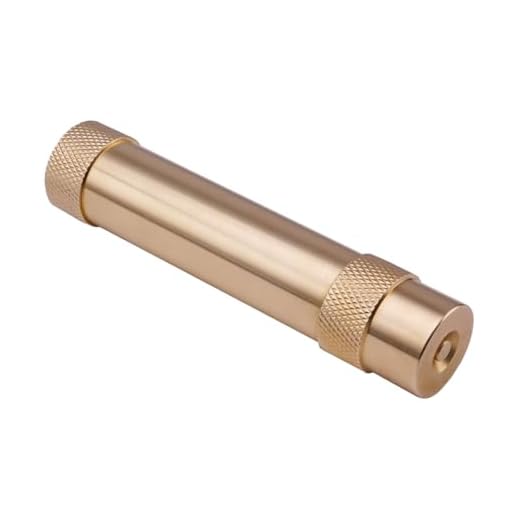
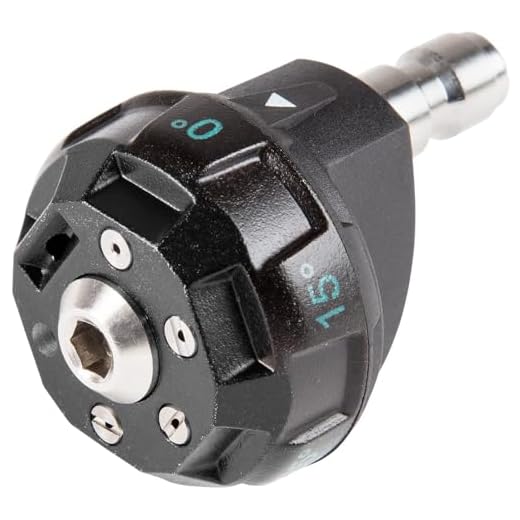

For efficient cleaning tasks, I recommend employing the 25-degree fan for most general applications. This attachment strikes a perfect balance between pressure and coverage, making it suitable for surfaces like driveways, patios, and vehicles. Its versatility allows for tackling dirt without risking damage.
If you’re dealing with more stubborn grime or mould, the 15-degree option is your best bet. This narrower spray delivers a concentrated jet that penetrates tough stains effectively, ideal for cleaning decks or concrete without excessive water use.
Conversely, for delicate surfaces such as wood or painted materials, the 40-degree tip offers a gentle mist that safely removes contaminants without causing harm. This attachment is especially effective for vehicles and garden furniture.
For heavy-duty tasks, consider a turbo nozzle. This variant combines the advantages of a powerful stream with oscillation, enhancing cleaning performance on tough surfaces like brick walls or commercial areas.
Finally, if your goal is to apply detergents or cleaners, choose a soap nozzle. Typically a wider spray, it allows for even distribution of cleaning solutions before rinsing, ensuring optimal results.
Recommended Tips for Choosing the Appropriate Tip
For optimal cleaning performance, I advise opting for the yellow tip (15 degrees) for tough surfaces like concrete, driveways, and patios. This attachment delivers a concentrated spray that effectively removes grime and stains without excessive wear on the material. Be cautious with its use on softer surfaces, as the high power can cause damage.
Alternative Options
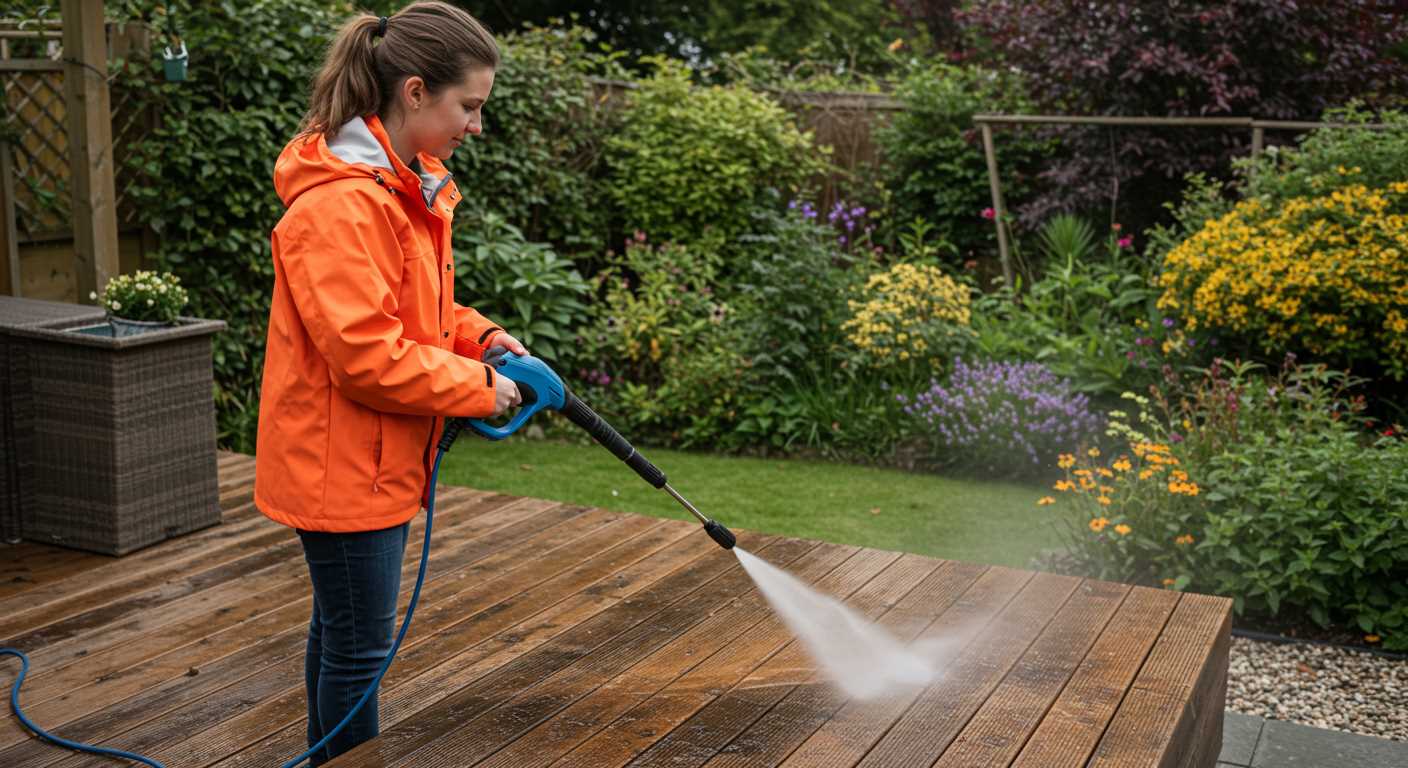
If dealing with delicate areas such as wooden decks or painted surfaces, switch to the white tip (40 degrees). This attachment provides a wider spray pattern that gently cleans without risking harm. It’s perfect for rinsing off soap or cleaning the exterior of your home.
Specialized Uses
For tasks requiring detergent application, use the black tip (soap) to mix cleaning solutions efficiently. This attachment works at low pressure, ensuring that you won’t oversaturate the area while applying your cleaner. Once the cleaning solution has taken effect, follow up with a high-pressure tip to rinse off the residue.
Understanding Pressure Washer Nozzle Colour Codes
Red indicates a zero-degree spray pattern, delivering the most concentrated force. This increases the risk of damage to surfaces, so reserve it for tough materials like concrete or tight spaces where precision is required.
Yellow represents a 15-degree angle, suitable for removing tough stains on hard surfaces. Opt for this when working on brick, metal, or stripping paint, but exercise caution to avoid surface damage.
Green corresponds to a 25-degree spray angle, offering a wider fan, which is ideal for general cleaning tasks such as patios, decks, and vehicles. It balances power and dispersion, making it a versatile choice.
White provides a 40-degree pattern, gentle enough for delicate surfaces like wood and painted areas. This is suitable for larger, less stubborn cleaning tasks, as it offers a gentle wash without risking damage.
Specialty Nozzles
Black denotes a soap application nozzle, designed for applying detergents effectively. This allows for a broader spread, ensuring effective cleaning solutions are adequately covered before rinsing.
Adjustable nozzles are another option, allowing for varied spray patterns. These can switch between different angles, providing flexibility for varying cleaning tasks without needing to change attachments.
Understanding these colour codes empowers better choices in maintaining equipment efficiency and protecting your surfaces. Familiarising yourself with these indicators can greatly enhance the effectiveness of your cleaning routine.
Choosing the Right Nozzle for Different Surfaces
For automotive exteriors, a 15-degree attachment is ideal. This attachment provides sufficient pressure for removing dirt without damaging the paintwork. Always maintain a distance of at least 2 feet from the surface.
When tackling wooden decks or fencing, opt for a 40-degree attachment. This wider spray angle gently cleans without stripping away the wood’s natural finish. Keep the distance around 12 inches to prevent splintering.
For concrete or masonry surfaces, select a zero-degree attachment. This concentrated jet efficiently eliminates tough stains and grime. However, be cautious and maintain at least a 3-foot distance to avoid surface etching.
In the case of siding made from vinyl or aluminium, the 25-degree attachment works best. It balances pressure and disperses water sufficiently to clean without causing wear. A distance of 1 to 2 feet is effective for optimal cleaning.
For delicate surfaces, such as cars or painted wood, always start with the widest angle and gradually move to a narrower setting if necessary. This approach minimises the risk of damage while allowing you to gauge the surface’s resilience.
Consider the type of dirt or stains present as well. For greasy residues, a higher-pressure attachment combined with an appropriate detergent can enhance cleaning efficiency. Always follow the manufacturer’s recommendations for detergents.
Lastly, remember to test a small, inconspicuous area before proceeding with a full clean. This ensures that neither the surface nor the attachment settings will result in damage.
How to Determine the Ideal Angle for Your Nozzle
Selecting the correct angle for your attachment is crucial for achieving optimal results while avoiding damage to surfaces. A 0° angle provides a concentrated stream, perfect for tougher stains on durable materials. However, caution is needed to prevent etching or discolouration.
Understanding Surface Types
For resilient surfaces like concrete and stone, a narrower angle can help remove stubborn grime effectively. On softer materials, such as wood or painted surfaces, a wider angle, typically around 25° to 40°, is recommended to prevent wear. The broader spray pattern distributes pressure evenly, reducing the risk of harm.
Adjusting for Specific Tasks
For tasks such as washing vehicles or delicate outdoor furniture, utilise a more gentle approach with a wider setting, which minimises the potential for damage. Conversely, tough jobs like stripping paint call for a narrower approach, but ensure that the distance from the surface is sufficiently maintained to mitigate impact stress.
Testing on a small, inconspicuous area always pays off. Adjust the distance and angle to see how surfaces respond before proceeding with the entire area. By understanding the interplay between angle and surface type, you can achieve effective cleaning while preserving the integrity of your items.
Common Mistakes When Selecting Nozzle Colours
One frequent oversight is assuming that a specific shade corresponds universally to its intended application. Each brand may have its unique coding, which can lead to confusion. Always check the manufacturer’s guidelines to ensure compatibility.
I’ve observed many individuals selecting the wrong angle for their task. It’s common to underestimate the power needed for removing tough grime; conversely, using a higher intensity on delicate surfaces can cause damage. Always match the angle to the surface condition rather than the perceived cleaning requirement.
Overlooking Surface Sensitivity
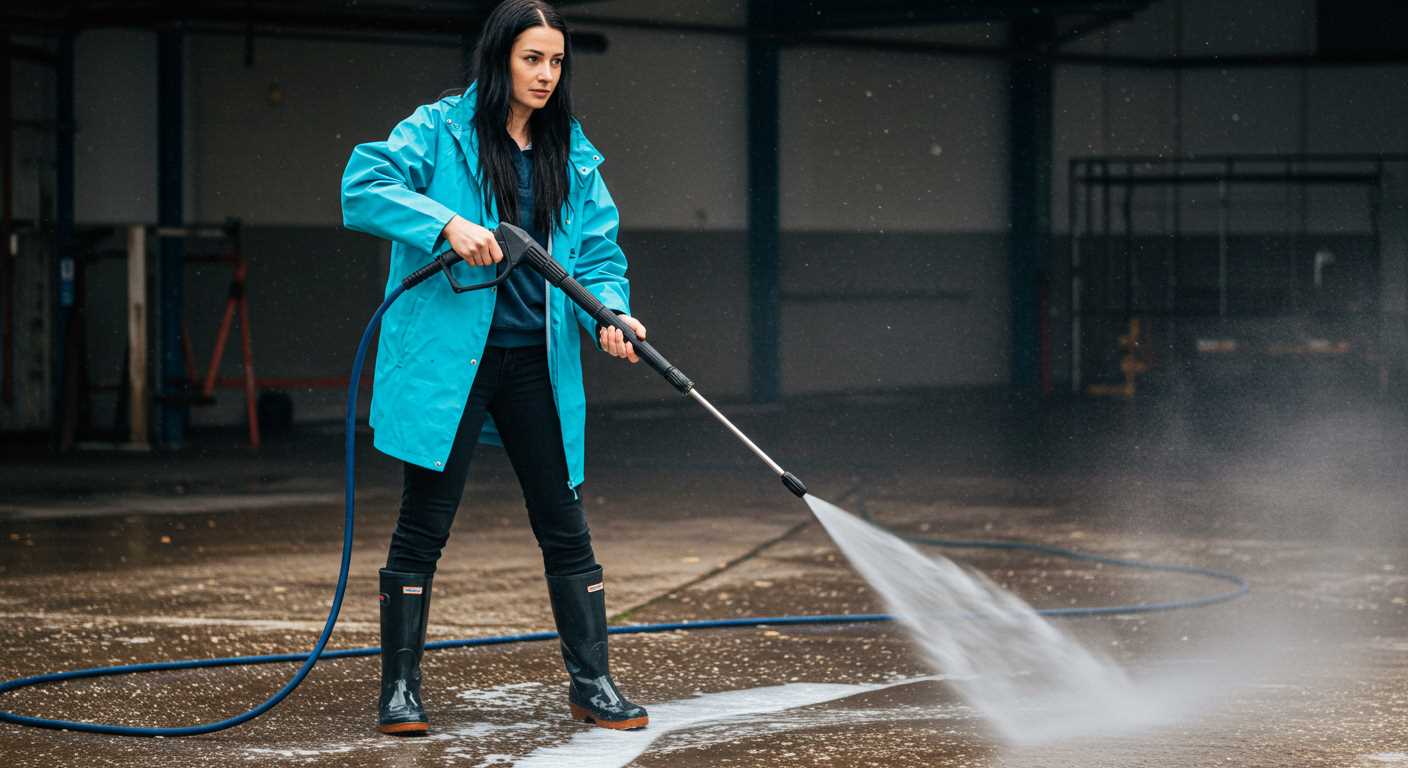
The composition of the surface often dictates the appropriate choice. For instance, a concrete driveway might handle a more abrasive option, whereas wooden decks require a gentler approach. Ignoring the material’s sensitivities may result in both inadequate cleaning and potential harm.
Failing to Test Before Committing
Another pitfall is neglecting the importance of testing different products on a small area first. Jumping right into a full wash without evaluating how the surface reacts to a particular intensity can lead to unintended consequences. A quick test can save both time and materials.
| Common Mistakes | Effects | Recommendations |
|---|---|---|
| Assuming universal coding | Incompatibility issues | Verify manufacturer’s guidelines |
| Using wrong angle intensity | Surface damage or ineffective cleaning | Match angle to surface type |
| Overlooking surface sensitivity | Damage to materials | Choose appropriately based on material |
| Not testing before use | Unintended damage | Perform a small patch test |
Factors Influencing Nozzle Choice Beyond Colour
The selection of the correct attachment encompasses more than just hue. Several key elements should be taken into account to enhance cleaning performance and protect surfaces.
- Pressure Rating: Ensure the attachment can handle the machine’s output. Mismatching can lead to inadequate cleaning or potential damage.
- Surface Type: Consider the materials and textures of the area to be cleaned. For delicate surfaces, a gentler option may be required, while more robust surfaces can withstand stronger attachments.
- Cleaning Task: Define the specific job requirements. For grease or heavy stains, a more focused spray may be necessary, while routine washing might require a wider fan.
- Water Volume: Some attachments work best with certain flow rates. Higher volumes can improve cleaning effectiveness but might not be suitable for all surfaces.
- Distance from Surface: The attachment’s design may influence how far away you should stand from the area being cleaned. Adjusting this distance can affect the cleaning power and prevent damage.
- Attachment Compatibility: Verify that the chosen accessory is compatible with your machine. Mismatched fittings can lead to inefficient operation.
Taking these factors into account not only optimises cleaning results but also extends the lifespan of both the cleaning equipment and the surfaces being treated.
Maintenance Tips for Pressure Washer Nozzles
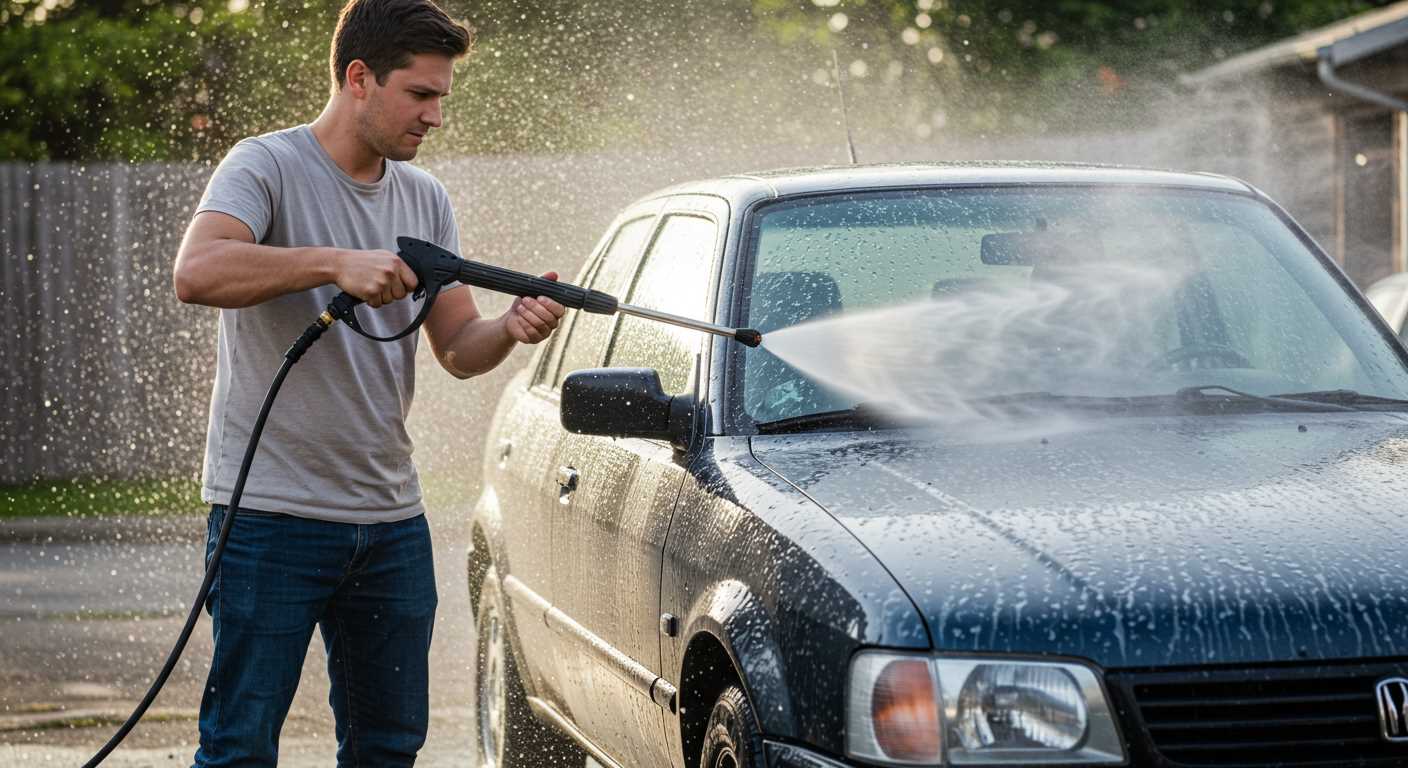
Regular cleaning is critical. After every session, rinse each tip under warm water to dislodge any remnants. For stubborn debris, a soft brush or cloth works well. If needed, a solution of vinegar and water can help dissolve mineral buildup.
Storage Practices
Store tips in a dry area, preferably in a protective case. Avoid placing them in high-humidity environments to prevent corrosion. Make sure each attachment is secured to prevent accidental bends or damages during storage.
Inspection for Wear
Frequent visual checks for cracks, signs of wear, or clogs will prolong lifespan. If I notice any issues, I replace that attachment immediately to maintain performance and safety. Always ensure that seals and O-rings are in great condition to prevent leaks.
FAQ:
What is the purpose of different coloured nozzles on a pressure washer?
Different coloured nozzles on a pressure washer indicate varying spray angles and pressures, allowing users to adjust the spray pattern based on the cleaning task. For instance, a red nozzle typically delivers a narrow, high-pressure stream suitable for tough stains, while a yellow nozzle offers a wider angle for more general cleaning. The green nozzle is ideal for medium-duty tasks, and the white nozzle provides a gentle spray for delicate surfaces. Understanding these distinctions helps in choosing the right nozzle to achieve the desired cleaning effect without causing damage.
How do I know which nozzle to use for cleaning my car?
When cleaning a car, it is recommended to use the white (40-degree) nozzle. This nozzle produces a wide spray pattern that is gentle enough for the vehicle’s surface but still effective in removing dirt and grime. If your car has stubborn stains, you may opt for the green (25-degree) nozzle, being cautious to maintain a safe distance from the paint. Keeping the nozzle at least a foot away from the surface helps prevent any potential damage. Always start with a lower pressure and adjust as needed.
Can using the wrong nozzle damage my surfaces?
Yes, using the wrong nozzle can potentially damage surfaces. For example, using a red (0-degree) nozzle on delicate materials, such as wood or painted surfaces, can lead to chipping, stripping, or gouging. It’s crucial to match the nozzle to the specific job at hand. Hard surfaces, like driveways or concrete, can generally handle higher pressure, while softer materials, such as wood or car paint, require gentler settings. Always check the manufacturer’s recommendations for the surfaces you intend to clean.
Is there a specific nozzle I should use for deck cleaning?
For deck cleaning, the green (25-degree) or yellow (15-degree) nozzle is typically recommended. The green nozzle offers a good balance of pressure and spray width, making it effective for removing dirt without excessive risk of damage. If there are tougher stains or algae, the yellow nozzle may be appropriate, but you should maintain a safe distance to avoid damaging the wood. Always test on a small, inconspicuous area first to ensure you do not harm the deck’s finish.








